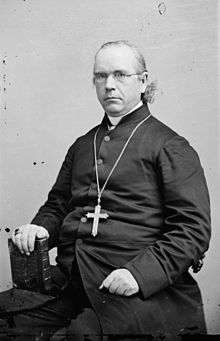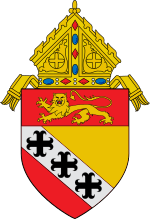Patrick Neeson Lynch
Patrick Neeson Lynch (March 10, 1817 – February 26, 1882) was an Irish-born clergyman of the Roman Catholic Church. He served as Bishop of Charleston from 1857 until his death in 1882.
Right Rev. Patrick Neeson Lynch | |
|---|---|
| Bishop of Charleston | |
 | |
| Church | Roman Catholic Church |
| See | Charleston |
| In office | December 11, 1857—February 26, 1882 |
| Predecessor | Ignatius A. Reynolds |
| Successor | Henry P. Northrop |
| Orders | |
| Ordination | April 5, 1840 |
| Consecration | March 14, 1858 |
| Personal details | |
| Born | March 10, 1817 Kibberidogue, County Fermanagh, Ireland |
| Died | February 26, 1882 (aged 64) Charleston, South Carolina, United States |
Biography
Patrick Lynch's birthplace is sometimes mistakenly attributed to Clones, County Monaghan but he was actually born in the County Fermanagh portion of the Parish of Clones, most likely in the townland of Kibberidogue where his family had settled in the mid to late 17th century. His parents were Conlaw Peter and Eleanor (née Neison) Lynch. Her father disapproved of the marriage and disinherited Eleanor. In 1819, he and his parents came to the United States, where they settled in Cheraw, South Carolina, and where like their neighbors, they too owned slaves.[1] Lynch was one of fourteen children, twelve of which lived to maturity. One of his sisters became a Carmelite nun in Baltimore, another became an Ursuline; his brother John was a doctor in Columbia, South Carolina.
He studied at the diocesan Seminary of St. John the Baptist, then went to the Pontificio Collegio Urbano de Propaganda Fide in Rome,[2] where he graduated with a Doctor of Divinity degree. He was ordained to the priesthood in Charleston in 1840 and served at the Cathedral of Saint John and Saint Finbar in Charleston. He was for a time editor of the United States Catholic Miscellany, founded by Bishop John England.
Bishop Reynolds appointed Lynch pastor of St. Mary's Church and vicar-general. Upon the death of Bishop Reynolds in 1855, Lynch became administrator of the diocese, and succeeded him as bishop. He was consecrated as bishop in March 1858. Lynch was the third bishop of the Roman Catholic Diocese of Charleston which at the time covered North Carolina, South Carolina, Georgia, the Bahamas and Bermuda. It was later subdivided leaving the Diocess of Charleston to cover only the state of South Carolina.
.jpg)
A disastrous fire in December 1861 destroyed the Cathedral of Saint John and Saint Finbar, the bishop's residence, and other valuable property, together with the diocesan library. The subsequent bombardment of the city for nearly two years during the Civil War wrought further damage, closed most of the churches, and depleted and impoverished the congregations.[2] On February 20, 1864 he was named by President Jefferson Davis of the Confederate States of America to be its delegate to the Holy See. Pope Pius IX, as had his predecessors, condemned chattel slavery. Despite Bishop Lynch's mission, and an earlier mission by A. Dudley Mann, the Vatican never recognized the Confederacy, and the Pope received Bishop Lynch only in his ecclesiastical capacity.[3][4] During his visit the Pope suggested that "something might be done looking to an improvement in [the slaves'] position or state, and to a gradual preparation for their freedom at a future opportune time."[5] General Sherman's occupation of Columbia was marked by the burning of St. Mary's College, the Sisters' Home, and the Ursuline Convent.
Immediately after the war, he stood in the midst of ruins, among a destitute and dejected people, with a diocesan debt of over $200,000 pressing upon him. He at once began to collect funds throughout the country for the immediate needs of his diocese and to liquidate its indebtedness. Lynch attended the First Vatican Council in 1869-1870.[2]
Bishop Lynch was a granduncle of pioneering US Naval aviator Patrick N. L. Bellinger.
References
- McAuley, Joseph. "The Two Irish Immigrant Churchmen Who Fought the American Civil War", America, April 8, 2015
- Duffy, Patrick Laurence. "Charleston." The Catholic Encyclopedia Vol. 3. New York: Robert Appleton Company, 1908. 7 February 2020

- Lonn, Ella (2002). Foreigners in the Confederacy. UNC Press. p. 592. ISBN 9780807854006.
- John Bigelow, The Southern Confederacy and the Pope, in 157 The North American Review 462, 468-75 (1893).
- Heisser, David C.R. (October 1998). "Bishop Lynch's Civil War Pamphlet on Slavery". The Catholic Historical Review. 84 (4).
![]()
Further reading
- Corr, Seán. "Bishop Patrick Lynch of Charleston and his visit to Roslea in 1864." Clogher Record, vol. 20, no. 2, 2010, pp. 359–372., https://www.jstor.org/stable/41224139.
- Heisser, David C. R., and Stephen J. White Sr. Patrick N. Lynch, 1817-1882: Third Catholic Bishop of Charleston (Columbia: University of South Carolina Press, 2015) 271 pp.
- Madden, Richard C. (1985). Catholics in South Carolina: A Record. University of America Press. ISBN 978-0-8191-4458-4.
| Catholic Church titles | ||
|---|---|---|
| Preceded by Ignatius A. Reynolds |
Bishop of Charleston 1857-1882 |
Succeeded by Henry P. Northrop |
